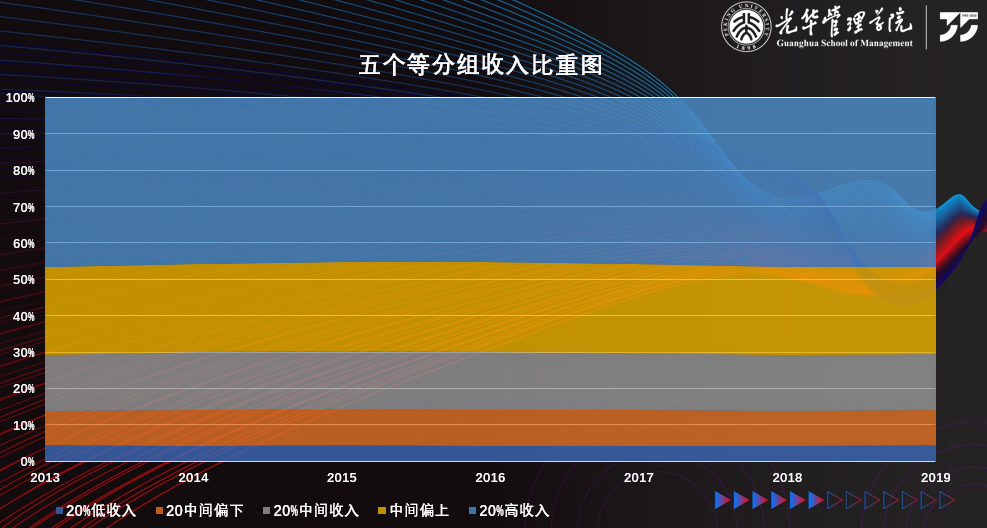The Central Economic Work Conference has set out eight key tasks in 2021, which are all related to industrial structure, income distribution and wealth structure. Chen Yuyu, Professor of Guanghua School of Management and Director of the Institute of Economic Policy at Peking University, believes that the eight major tasks mainly respond to two major risks: the uncertainty of international relations and the need to balance domestic reform and opening up.

1. Two risks that the eight tasks strive to tackle
The Central Economic Work Conference has set out eight key tasks in 2021, mainly in response to two major risks: the uncertainty of international relations and the need to balance domestic reform and opening up. In addition, these two risks are also compounded by the impact of the COVID-19 outbreak. From a broader perspective, these eight tasks not only set our agenda for the next year, but also our next stage of development.
These eight tasks are as follows: strengthening national strategic science and technology power; building more independent and controllable industrial supply chains; adhering to the strategic basis of expanding domestic demand; promoting all-around reform and opening-up; settling issues of farmland and seeds and guarantee food safety; improving regulations on anti-monopoly and avoid blind expansion of capital; solving the housing problem in big cities and striving to reduce carbon emissions.
2. The five income brackets
China's post-taxation household disposable income can be divided into five groups. The top 20%, about 300 million people, accounts for 46% to 47% of the national income. The second bracket is the “middle class”, where 20% of the population account for more than 20% of national income. In other words, there are about 500 million to 600 million people accounting for 40% of national income. Subsequently, 800 million to 900 million people account for about 30% of the total income. According to their income levels, the population can also be roughly divided into three groups: 20% of the population belongs to the high-income group, 40% belongs to the middle-income group and 40% belongs to the low-income group.

Changes to the industrial structure are demand-driven. How then is the demand structure determined? This lies primarily in income level. The high-income group consists of about 300 million of the population. Their income determines their demand levels, which in turn determines production levels. Therefore, the upcoming task is to “expand domestic demand”. Expanding domestic demand is not simply a matter of increasing financial input, but rather increasing connectivity between sectors and employment, which includes improving income distribution and hence enhancing compatibility between production and the needs of urban and rural low-income people.
3. Similar growth rates in the five income brackets
In the past 7 years, we have observed similar growth rates in our high-income, middle-income and low-income groups. While the high-income groups grew at a faster rate prior to the 18th National Congress eight years ago, the growth rate of middle and high income has kept pace with each other since then.
Upon closer look, we can see that 60% of China's population accounts for about 30% of the total income. 60% of the population represents more than 800 million people, and their income has increased at the growth rate of per capita GDP, which is equal to the growth rate of those in the high-income group. If this growth rate can be sustained, after 12 or 13 years, their per capita income, and thus disposable income can also be doubled, of which about 400 million people will be able to afford cars. Therefore, the key of our developmental model is to allow the five income brackets to grow at a relatively balanced speed.
4. The decisive force behind changes in our future industrial structure
In a nutshell, the changes of income distribution resulted from complex forces. In the past ten years, we have performed quite well in these aspects. We will have to continue with this inclusive growth model, where entrepreneurs will have to pay attention to the changes in income distribution. In principle, a country's per capita income level determines its industrial structure. Such indicators are also used by the research group led by Dean Liu Qiao of Guanghua School of Management in determining future changes in the industrial structure.

The 14th Five-Year Plan also states that that we should keep the share of manufacturing relatively stable in the next 15 years. In addition, the Ministry of Industry and Information Technology has recently stated that we should strive to be stronger, more practical and better in manufacturing, but not bigger. This is a sign of caution. In my opinion, the future share of the manufacturing industry depends on how we expand domestic demand and tap on the people from the bottom 60% income bracket. Their consumption level is still that of the first group 15 to 20 years ago, while they will constitute a huge demand in the next 15 years.
Of course, this increase in demand will occur against the backdrop of deepening reforms in areas such as urbanization, long-term rental housing, housing prices and others. We will have to consider if these policies truly facilitate inclusive economic growth, and whether we are ready to integrate these 800 million people into urban life while providing them with jobs and housing in the cities. Therefore, our future is full of challenges and opportunities, which will also require us to call on the creativity and imagination of our people.
About Professor Chen Yuyu
Chen Yuyu is currently a Professor of Applied Economics at Guanghua School of Management, Peking University, and the Director of the Institute of Economic Policy, Peking University. In 2014, he won the National Natural Science Fund for Distinguished Young Scholars, and was selected as a Distinguished Professor under the Ministry of Education’s Changjiang Scholars Programme in 2016. His research interests include economic development and productivity, human capital and growth, health and pollution, behavioural economics and labour market, income distribution, regional differences, and others. His research has been published in international academic journals such as Proceedings of the National Academy of Sciences of the United States (PNAS). He has also won the second prize in the Ministry of Education’s Outstanding Achievement Award of Social Sciences in Colleges and Universities, the Li Yining Research Award, the Outstanding Teaching Award of Peking University, and the Teaching Excellence Award of Guanghua School of Management.
 Programs
Programs